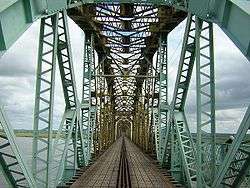Brodie Henderson (engineer)
Sir Brodie Haldane Henderson, KCMG, CB (1869 – 28 September 1936) was a British civil engineer.[1] Henderson was primarily a railway engineer who worked for many railroad corporations across South America, Australasia and Africa. He was the consultant for the Dona Ana Bridge which, when it was built in 1935, was the longest railway bridge in the world with a length of 2.24 miles. He volunteered for service with the Royal Engineers at the outbreak of the First World War and was put in charge of railway lines used to tranposrt Allied troops and supplies. In this capacity he held the rank of a Brigadier-General of the British Army and his success in this role resulted in him being decorated by the British, French and Belgian governments.
After the war Henderson worked with the Imperial War Graves Commission, as High Sheriff of Hertfordshire in 1924 and as president of the Institution of Civil Engineers. He was an important patron of John William Waterhouse, the pre-Raphaelite painter, and was the original owner of Gather Ye Rosebuds While Ye May.
Early life
Henderson was born in Ealing, Middlesex to George and Eliza Henderson, his elder brother was Alexander Henderson the businessman and politician. He studied at King's College London and Victoria University in Manchester. He began his engineering career with Beyer, Peacock and Company, the locomotive manufacturer, and later worked for James Livesey and Son, a firm of consulting engineers, of which he would become a partner.[1]
Professional career

His work with James Livesey was mainly railway contracts, often financed by Brodie's brother Alexander. Henderson became a senior partner of the firm in 1893 and upon James' retirement it became known as Livesey and Henderson. Henderson worked extensively on railway contracts in abroad including the Buenos Aires Great Southern, Central Argentine, Antofagasta and the Midland of Western Australia railways. Henderson was also responsible for the construction of new docks in Buenos Aires.[1]
His most famous project is the Dona Ana Bridge over the Zambezi River in Mozambique for the Beira Railroad Corporation, this bridge was built in 1935 and spanned a distance of 2.24 miles by 33 separate arches. This bridge was the longest railway bridge in the world for many years.[1]
Military service
Henderson volunteered for a commission in the Royal Engineers at the start of the First World War and was made the deputy director-general of transportation in Belgium and France, being chiefly concerned with railway transport. During his war service he was mentioned in dispatches on four occasions and rose to the rank of Brigadier-General.[1] His war work was recognised by his appointment as a companion of the Order of St Michael and St George in 1918, the next year he was promoted to knight of the same order and also made a companion of the Order of the Bath. In addition to this the French government appointed Henderson an officer of the Légion d'honneur, as well as the Croix de Guerre, and the Belgian Government appointed him a commander of the Order of the Crown.[1]
Post-war work
After the war Henderson worked as an honorary consulting engineer to the Imperial War Graves Commission and served as High Sheriff of Hertfordshire between 1924 and 1925.[2] Henderson was elected the president of the Institution of Civil Engineers in 1928.[3]
Personal life

Henderson became, through his brother Alexander, a patron of John William Waterhouse and owned several of his paintings.[4] He was the original owner of Gather Ye Rosebuds While Ye May, a 1909 painting by Waterhouse that was recently valued at CAD$4.8 million to $7.3 million.[5]
He married Ella Jones in 1901 and fathered a daughter, Joan, and three sons, Gerald, Neil and Andrew. Neil, Andrew followed their father as partners in Livesey and Henderson, as did one of Alexander's sons Philip. Brodie died on 28 September 1936 of lung cancer and was cremated at Golders Green before being interred in the family grave at Braughing. A memorial service was held at St Michael's Church in the City of London.[1]
References
- 1 2 3 4 5 6 7 Dictionary of National Biography entry
- ↑ List of High Sheriffs Archived 9 September 2008 at the Wayback Machine.
- ↑ Watson, Garth (1988), The Civils, London: Thomas Telford Ltd, p. 252, ISBN 0-7277-0392-7
- ↑ Waterhouse patronage
- ↑ CBC news report on painting
| Professional and academic associations | ||
|---|---|---|
| Preceded by Ernest Crosbie Trench |
President of the Institution of Civil Engineers November 1928 – November 1929 |
Succeeded by William Grierson |